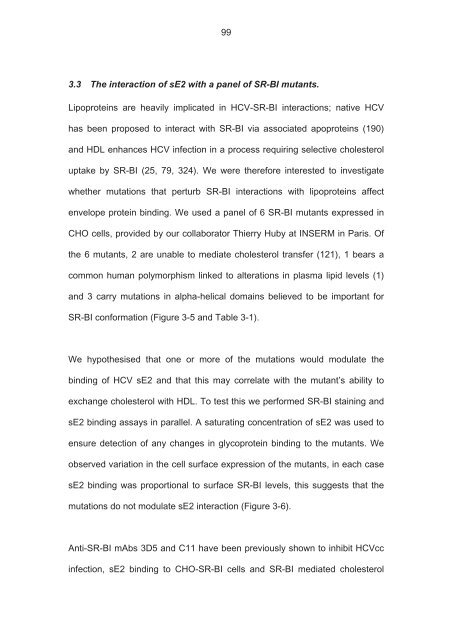The role of scavenger receptor BI in hepatitis - eTheses Repository ...
The role of scavenger receptor BI in hepatitis - eTheses Repository ...
The role of scavenger receptor BI in hepatitis - eTheses Repository ...
Create successful ePaper yourself
Turn your PDF publications into a flip-book with our unique Google optimized e-Paper software.
99<br />
3.3 <strong>The</strong> <strong>in</strong>teraction <strong>of</strong> sE2 with a panel <strong>of</strong> SR-<strong>BI</strong> mutants.<br />
Lipoprote<strong>in</strong>s are heavily implicated <strong>in</strong> HCV-SR-<strong>BI</strong> <strong>in</strong>teractions; native HCV<br />
has been proposed to <strong>in</strong>teract with SR-<strong>BI</strong> via associated apoprote<strong>in</strong>s (190)<br />
and HDL enhances HCV <strong>in</strong>fection <strong>in</strong> a process requir<strong>in</strong>g selective cholesterol<br />
uptake by SR-<strong>BI</strong> (25, 79, 324). We were therefore <strong>in</strong>terested to <strong>in</strong>vestigate<br />
whether mutations that perturb SR-<strong>BI</strong> <strong>in</strong>teractions with lipoprote<strong>in</strong>s affect<br />
envelope prote<strong>in</strong> b<strong>in</strong>d<strong>in</strong>g. We used a panel <strong>of</strong> 6 SR-<strong>BI</strong> mutants expressed <strong>in</strong><br />
CHO cells, provided by our collaborator Thierry Huby at INSERM <strong>in</strong> Paris. Of<br />
the 6 mutants, 2 are unable to mediate cholesterol transfer (121), 1 bears a<br />
common human polymorphism l<strong>in</strong>ked to alterations <strong>in</strong> plasma lipid levels (1)<br />
and 3 carry mutations <strong>in</strong> alpha-helical doma<strong>in</strong>s believed to be important for<br />
SR-<strong>BI</strong> conformation (Figure 3-5 and Table 3-1).<br />
We hypothesised that one or more <strong>of</strong> the mutations would modulate the<br />
b<strong>in</strong>d<strong>in</strong>g <strong>of</strong> HCV sE2 and that this may correlate with the mutant’s ability to<br />
exchange cholesterol with HDL. To test this we performed SR-<strong>BI</strong> sta<strong>in</strong><strong>in</strong>g and<br />
sE2 b<strong>in</strong>d<strong>in</strong>g assays <strong>in</strong> parallel. A saturat<strong>in</strong>g concentration <strong>of</strong> sE2 was used to<br />
ensure detection <strong>of</strong> any changes <strong>in</strong> glycoprote<strong>in</strong> b<strong>in</strong>d<strong>in</strong>g to the mutants. We<br />
observed variation <strong>in</strong> the cell surface expression <strong>of</strong> the mutants, <strong>in</strong> each case<br />
sE2 b<strong>in</strong>d<strong>in</strong>g was proportional to surface SR-<strong>BI</strong> levels, this suggests that the<br />
mutations do not modulate sE2 <strong>in</strong>teraction (Figure 3-6).<br />
Anti-SR-<strong>BI</strong> mAbs 3D5 and C11 have been previously shown to <strong>in</strong>hibit HCVcc<br />
<strong>in</strong>fection, sE2 b<strong>in</strong>d<strong>in</strong>g to CHO-SR-<strong>BI</strong> cells and SR-<strong>BI</strong> mediated cholesterol

















